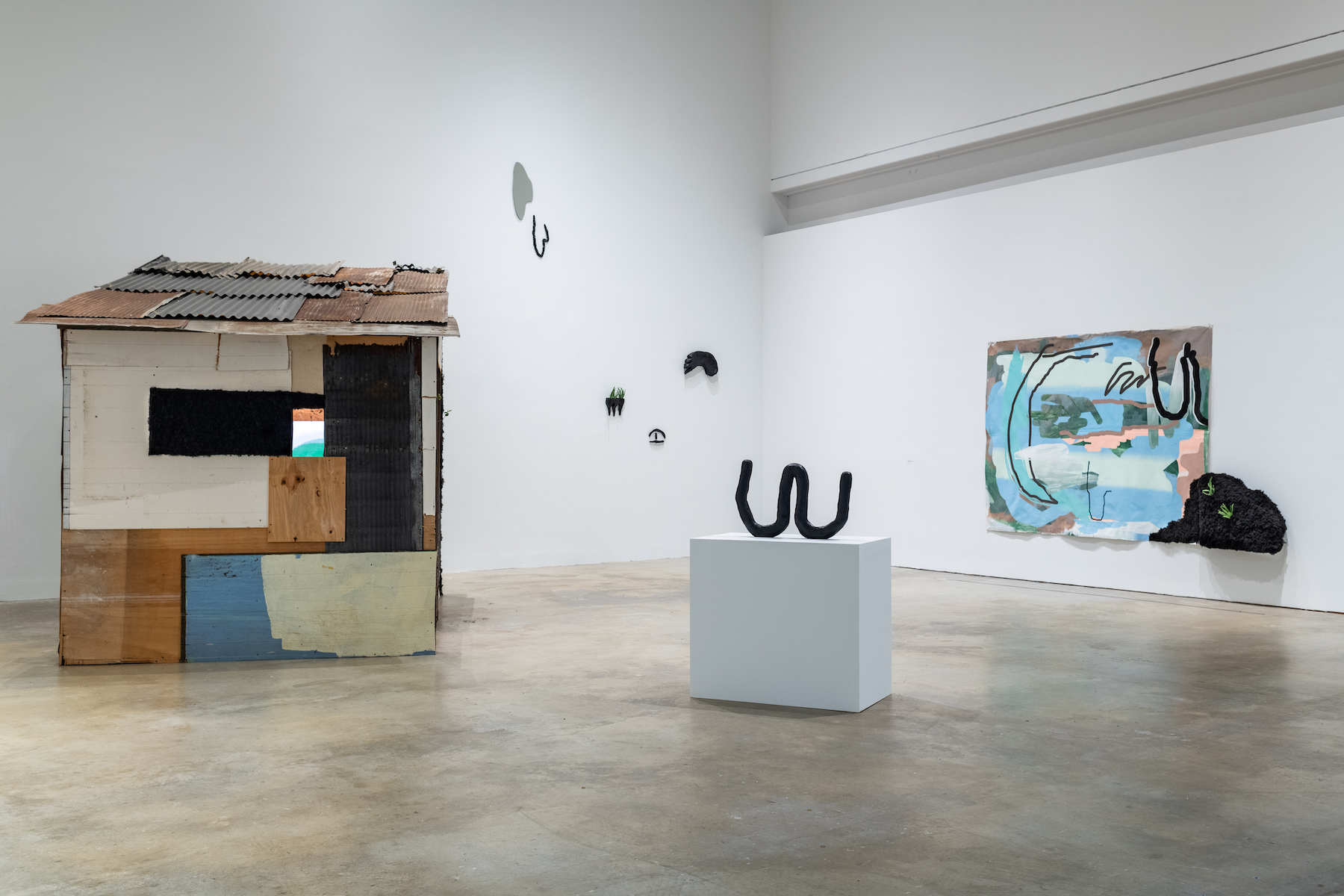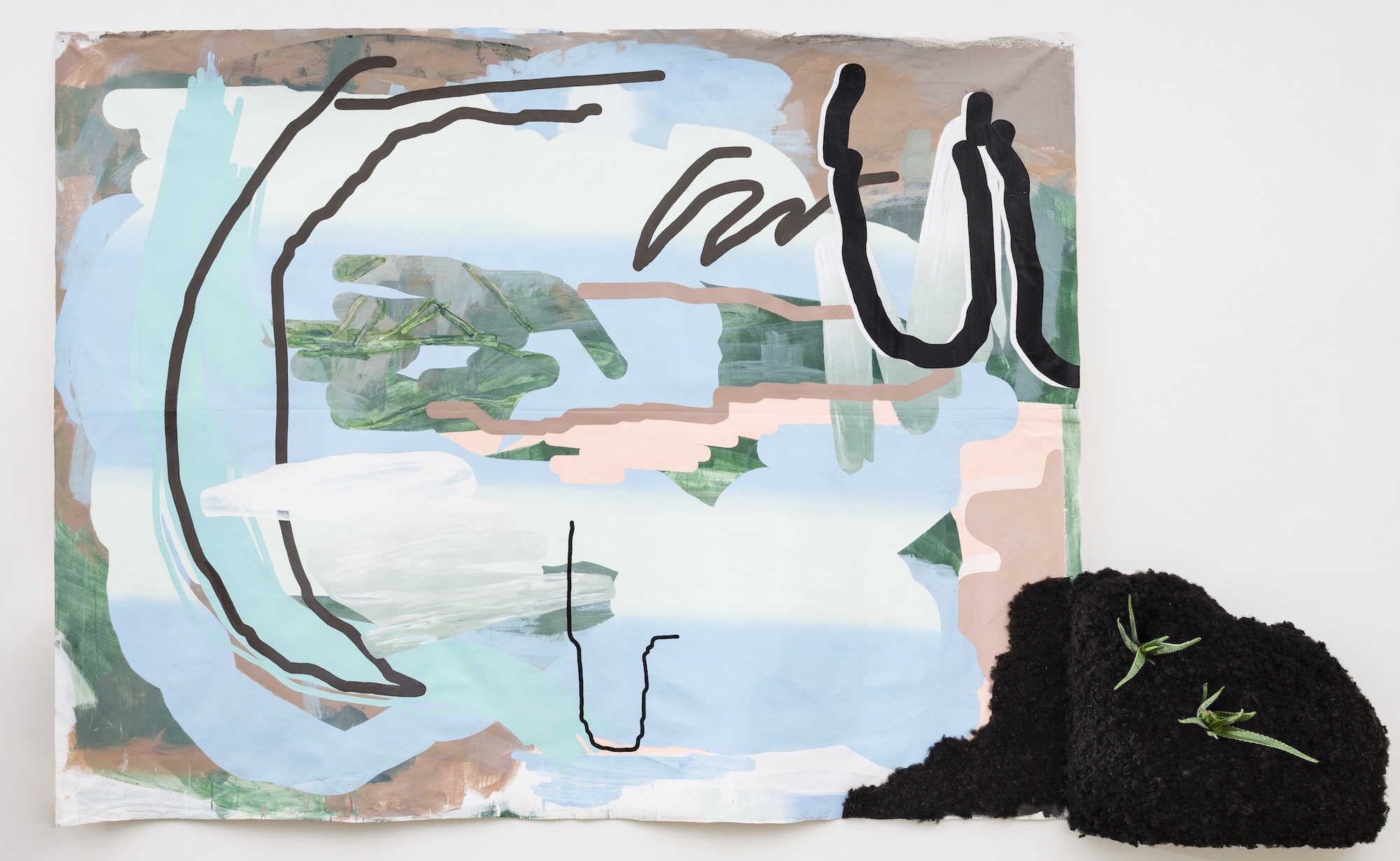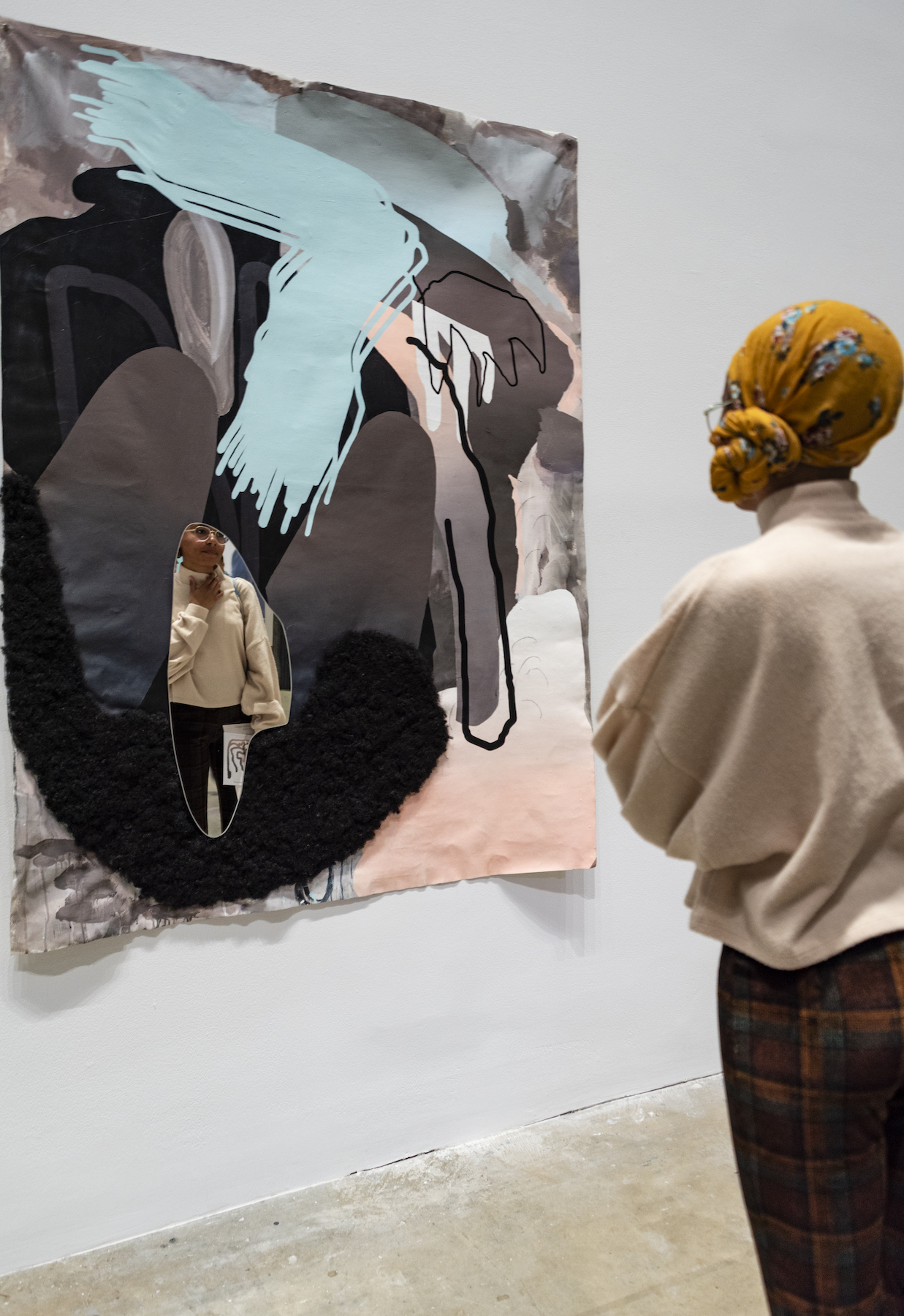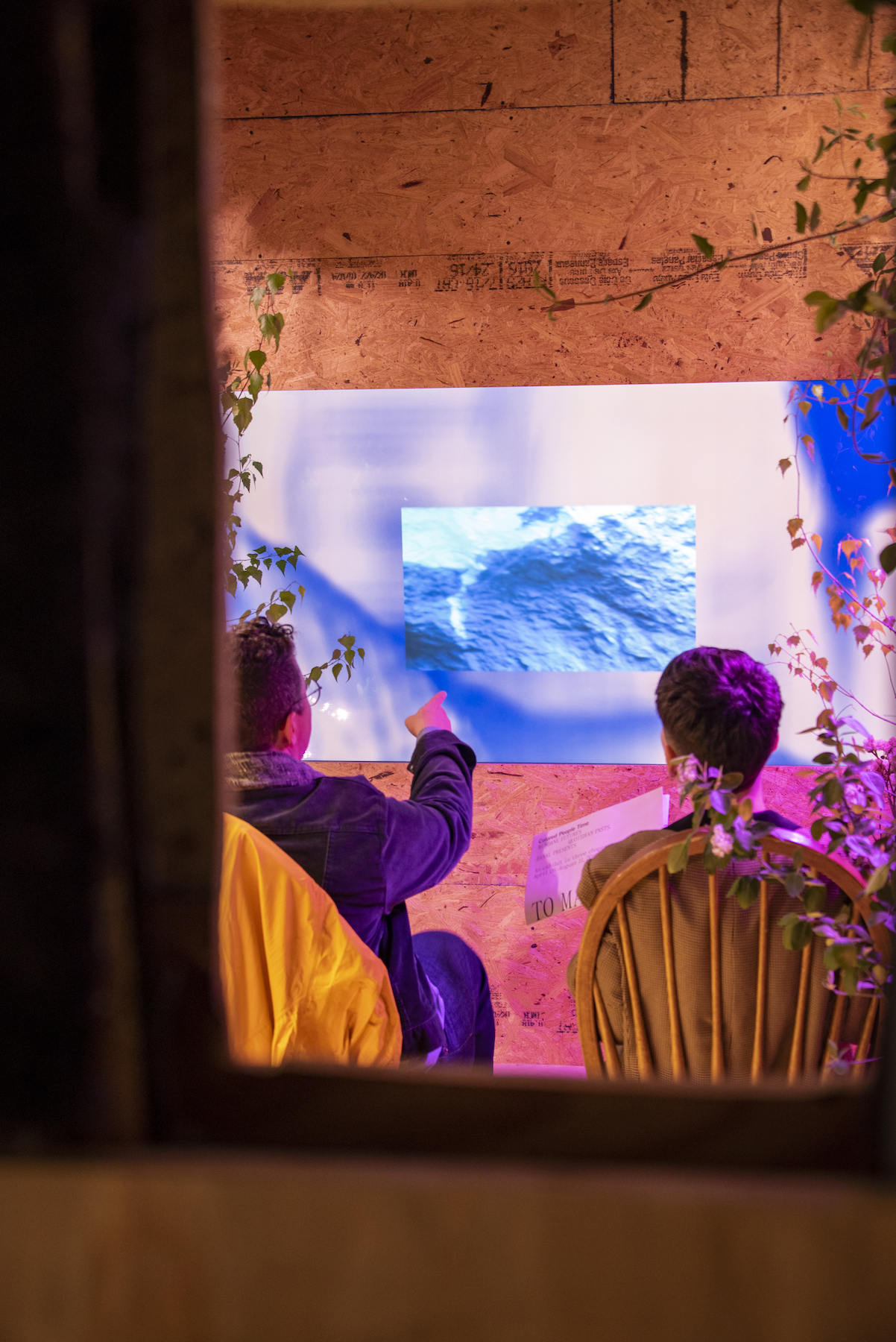Deborah Anzinger: An Unlikely Birth
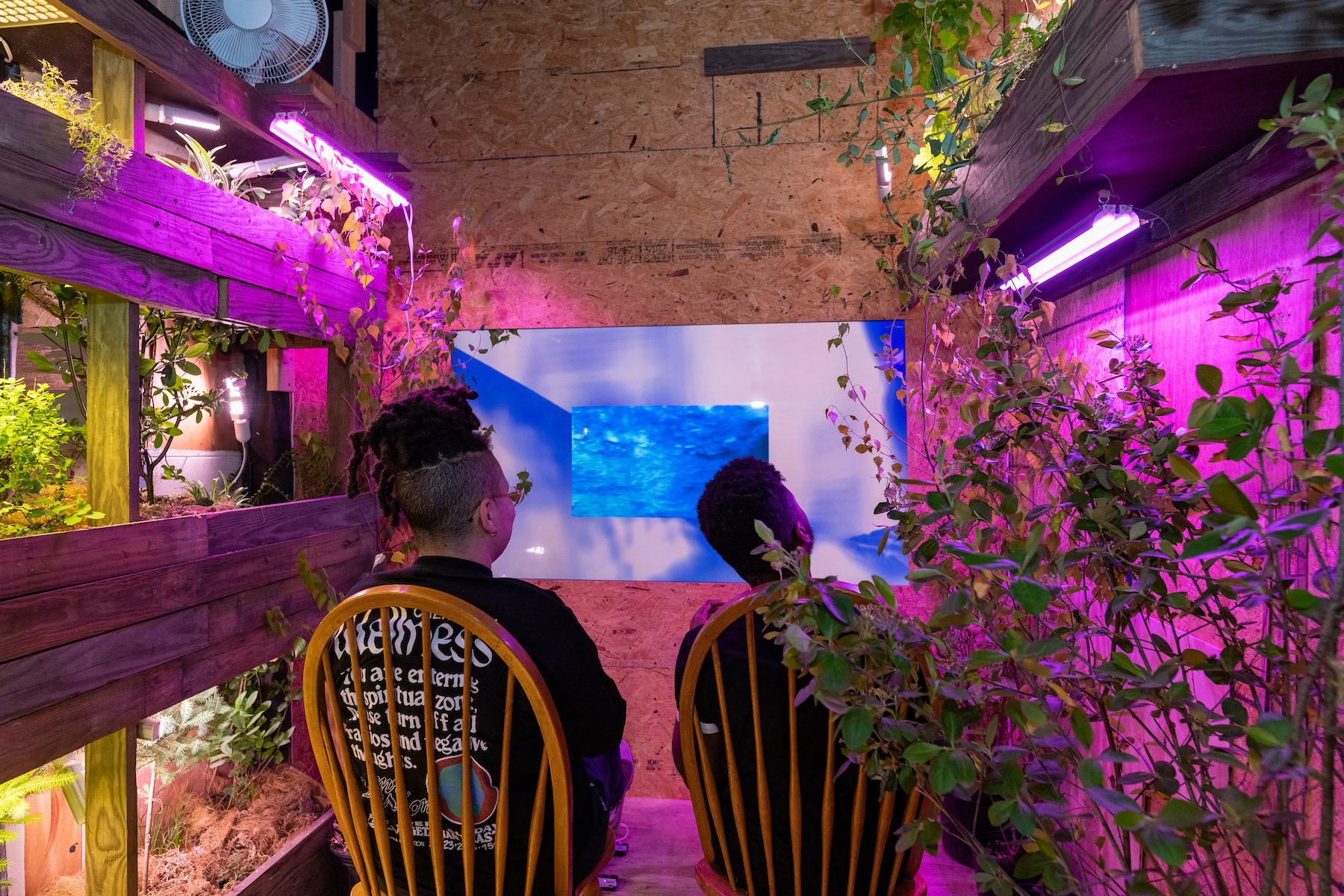
Deborah Anzinger, “An Unlikely Birth,” 2018, acrylic, mirror, and synthetic hair on canvas and polystyrene, 80 x 131 inches [photo: Constance Mensh; courtesy of the artist and Institute of Contemporary Art in Philadelphia]
Share:
In an epigraph to her book Zong!—a meditation on the 1781 massacre of an estimated 150 slaves in the Middle Passage, somewhere between Ghana and Jamaica—poet M. NourbeSe Philip quotes St. Augustine, Praesens de praeteritis: the past is ever present. With splintered bits of language pulled from legal text, Zong! dismantles and pulls apart and reconstructs the horrors of black fungibility, asking what specters remain in the vast expanse of the Atlantic.
What Philip does for water, Deborah Anzinger does for soil. An Unlikely Birth, the artist’s first solo museum exhibition in the United States, unfolded along the temporal lines sketched by Philip, pulling the past and an uncertain future into the present. In serial and small-scale framed paintings; large, sprawling, unframed canvases; architectural elements; and ceramic pieces that dotted the gallery walls and floors, An Unlikely Birth was full of organic material: many of these works feature either cloudlike puffs of synthetic black hair, Aloe barbardensis plants, or both.
Deborah Anzinger, An Unlikely Birth, installation view, April 26-August 11, 2019 [photo: Constance Mensh; courtesy of the artist and Institute of Contemporary Art in Philadelphia]
Positing the plantation as the birthplace of capitalism, Anzinger investigates how the spilled blood of captured Africans comes to rest in the soil, whether transnational trauma has a half-life, and what specimens this soil produces. In other words, Anzinger ties the imminent planetary crisis of climate collapse to the ongoing legacy of racial violence. Anzinger’s materials took on different inflections within the white walls of the Institute of Contemporary Art, through the exhibition’s politic of black liberation. The aloe plants that emerge from ceramic forms and piles of hair throughout her work seem to reference Anzinger’s native Jamaica as much as an IKEA showroom, or even the institutional framework in which An Unlikely Birth exists. (In other contemporary institutions—such as the Guggenheim Museum, where rows of neatly planted sansevieria separate the art from the emergency exits—living matter is often used decoratively.) Just as the aloe plants in the artworks Eye and An Unlikely Birth grew, so too did the loops of synthetic hair adhered to canvas in Garden (all 2018) seem poised to expand, morph, or perhaps wilt and wither; and a series of small canvases here was titled Growth Index. Anzinger’s work is alive, and life is unstable. This instability exists both materially and connotatively: what happens to organic matter over time? What are the risks of mapping black geographies with succulents, mirror fragments, playful ceramics, and millennial pink?
The exhibition felt generously spaced while retaining a certain fullness thanks to The Distraction of Symbolism (2019), a patchwork shed containing shelves full of plants, grasses, and mosses; a looping video work; and two chairs placed before a pair of pedals fixed to the floor. Visitors’ pedaling set off two mechanisms overhead: the movement of an oscillating fan, and the flickering of pink and yellow grow lights. In a reversal of the schema wherein planetary death will come about as a result of capitalism’s delusion of endless expansion through human labor, Anzinger’s organic matter benefitted from the help of such labor. By the same token, the pedaling felt cheap—a momentary diversion. Anzinger imbues this corner of An Unlikely Birth with hope for betterment through collective efforts alongside real skepticism toward the notion that individual, short-term, drop-in efforts can affect change at the scale and pace currently needed.
Deborah Anzinger, An Unlikely Birth, 2018, acrylic, mirror, and synthetic hair on canvas on polystyrene, 80 x 131 inches [photo: Constance Mensh; courtesy of the artist and Institute of Contemporary Art in Philadelphia]
Most of Anzinger’s paintings are made with some combination of acrylic paint and synthetic hair, yet they share a digital quality, as if they’ve been executed in Microsoft Paint with certain layers selectively erased. In an artist talk at ICA, Anzinger noted that these squiggly compositions—and her practice more generally—are concerned less with bodily representation and more with subjecthood. Still, she spoke of An Unlikely Birth, perhaps the exhibition’s centerpiece, as the first work in which she references the male body—as a space in which the male body might enter the connotative space of nature alongside women. At more than 6 feet tall by 10 feet wide, An Unlikely Birth is monumental in scale compared to most of Anzinger’s canvases, and it features a tangle of black hair at bottom right, out of which two aloe plants emerge. It’s a landscape, and though it is beautiful, it’s foreboding too: its axes are impossible to locate, and sand, sea, sky, forest, and the human body itself are all jumbled together. I wouldn’t have noticed the male qualities of the work had Anzinger herself not pointed them out, but within the Anthropocene, can an artist ethically paint a landscape without inclusion of the human in some form or another?
Against the narrative of a future apocalypse, Anzinger’s work is firmly rooted in the ongoing catastrophes of a choking climate that are disproportionately brought to bear on the populations of the Global South. What is footnoted in the predominantly white US environmental justice movement was here given full focus, and the future-focused concerns of climate activism were complemented by Anzinger’s understanding of the earth’s matter as indelibly marked by human patterns of the past. Then there were moments in An Unlikely Birth when temporality took on different forms altogether, as in the playful bits of mirror that emerge unexpectedly from Anzinger’s canvases. These elements are like portals gaping into another dimension, even if that dimension is undefinable, or, in fact, just our own reflection.
Deborah Anzinger, An Unlikely Birth, installation view, April 26-August 11, 2019 [photo: Constance Mensh; courtesy of the artist and Institute of Contemporary Art in Philadelphia]
Deborah Anzinger, An Unlikely Birth, installation view, April 26-August 11, 2019 [photo: Constance Mensh; courtesy of the artist and Institute of Contemporary Art in Philadelphia]
Heather Holmes is a writer and editor whose work concerns the specificities of the body and the built environment.
